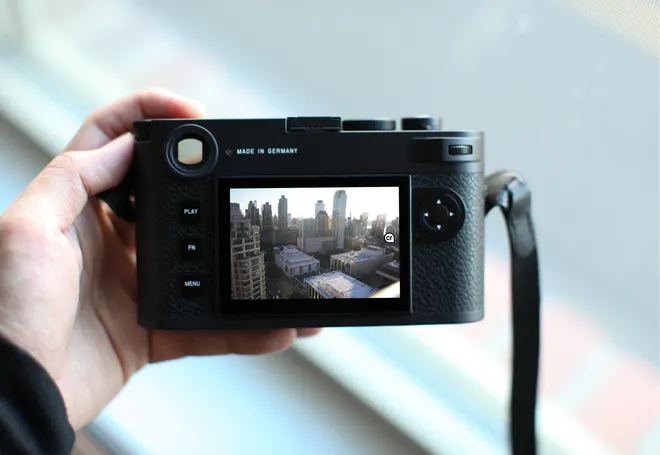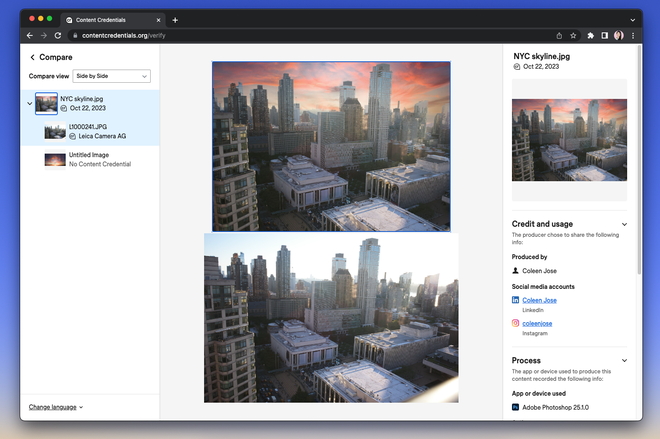The fight against fake photos: How Adobe is embedding tech to help surface authenticity
The menace of fake imagery is evident, especially during these politically sensitive and emotionally charged times. The threat will grow exponentially with the latest generative artificial intelligence tools that can create natural-looking artificial images, video, and audio.
These days, fact-checking is painstaking manual work done by experts. But all that is about to change soon, thanks to the ongoing efforts led by the Content Authenticity Initiative (CAI), co-founded by Adobe in 2019, to bring trust and transparency to digital content. CAI is developing a technology called Content Credentials, a "nutrition label" for content that could be embedded into digital content.

Today, Lecia, the premier camera maker, announced the M11-P, the first camera with Content Credentials built-in. Pictures taken by M11-P will have the Content Credentials symbol as a setting option that, when turned on, will attach information, including the creator or owner, device, date and time, and more – delivering authenticity at the point of capture.
Don't fall for AI deepfakes:Here's how to spot them
This is only the beginning. The underlying technology is set to revolutionize and simplify how all content is authenticated, whether captured by a camera or created by AI.
How Content Credentials work
Simplified image authentication is made possible by two entities: First, an industry standards group that collaborates on this technology specification called the Coalition for Content Provenance and Authenticity (C2PA), and second is CAI, the large cross-industry forum mentioned above.
The authenticity information is embedded in a tamper-evident format when creating digital content using any device that supports Content Credentials technology, whether it is a camera or an app on a phone or computer. If this information is altered or stripped off at any point in the content's lifecycle, you will see it in the Content Credentials history.

Every time the content is edited, the same information about the editor is appended to the record. This history can be seen by simply clicking the Content Credential symbol on the content or by uploading it to https://contentcredentials.org/verify.
Not just authenticity, this technology will be crucial for establishing content ownership – helping creators get credit for their work.
How soon will this technology be widely available?
Because of the burgeoning threat of fake imagery, there is a groundswell of support for this transparency-based approach. The CAI is reaching nearly 2,000 members across a broad spectrum of industries, including Nikon, Canon, the New York Times, the Associated Press, the BBC, Reuters, The Wall Street Journal, Qualcomm, Microsoft, and more. Then, the C2PA has over 60 members, including the who's who of technology and content creator ecosystem, such as Adobe, BBC, Canon, Intel, Microsoft, Sony, and others, including Gannett, USA TODAY's parent company.

Leica's announcement with its latest camera and the new Content Credentials feature is only the beginning. The company not only makes its own high-end cameras but also supplies cameras to many major smartphone makers, such as Huawei and Xiaomi. So, we could see support for this feature in those phones soon, too. Smartphone giant Qualcomm's latest Snapdragon8 Gen3 platform's camera system also supports C2PA-based authentication.
Many generative AI-based content creator platforms, such as Adobe Firefly, Microsoft Bing Image Creator, and others, have also announced the adoption of Content Credentials. Recently, Google announced that its SynthID will embed the watermark directly into images created by its Gen AI tools.
Since this technology benefits the $5-billion digital rights management industry, this effort is not only societal but also a major business imperative for a score of large global conglomerates.
With such strong cross-industry support and the dire need, widespread adoption is only a matter of time.
The revolution to identify fake and fabricated imagery has started, and the announcement from Leica is a small, visible first step in that direction. Very soon, you will not be in limbo about an image being "real or fake." Instead, you will have transparency and context to decide for yourself.
Prakash Sangam is founder and principal of Tantra Analyst. The views and opinions expressed in this column are the author's and do not necessarily reflect those of USA TODAY.
Follow him on X @MyTechMusings.
Disclaimer: The copyright of this article belongs to the original author. Reposting this article is solely for the purpose of information dissemination and does not constitute any investment advice. If there is any infringement, please contact us immediately. We will make corrections or deletions as necessary. Thank you.







